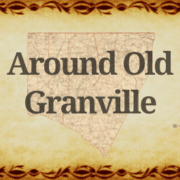TownTalk: Around Old Granville – Henderson Cotton Mill Strike Pt.2
The Henderson cotton mill strike of 1958 began as a relatively peaceful protest when workers and company leaders couldn’t agree about how to settle disagreements – for years, both sides had agreed to use arbitration as a way to settle disputes about a variety of grievances, said local historian Mark Pace.
And, Pace said, it seemed to work out that, over those years, about half the judgments were found in favor of the workers, and half in favor of the company.
The strike made headlines across the country and beyond, Pace noted in Thursday’s Around Old Granville segment of TownTalk with WIZS’s Bill Harris. And in February 1959, after months of being shut down, the mill management decided to take action.
“The Coopers put out a call for strike breakers,” Pace said. “they wanted to run one shift and crank up production.” The inventory of yarns and cotton that had been stockpiled was running low, and so the mill needed to be running again.
“Until that point, the strike had been relatively peaceful,” Pace said. But when strikebreakers were brought in, that’s when things turned violent.
There were at least 16 cases of bombings between February and May 1959. Warehouses were bombed, homes were bombed, windows shot out. About 150 people were arrested, but Pace said local law enforcement was stretched beyond its limits.
The mills in North Henderson and South Henderson both were outside the city limits, so it was up to the sheriff’s office to keep things calm near the mills as best they could.
Gov. Luther Hodges, himself once a textile mill vice president, Pace explained, called the State Highway Patrol into action to help keep the peace in Henderson. Eventually, however, the National Guard got involved.
A man making a cotton delivery to one of the mills was attacked by a mob of protesters,prompting a judge to rule that a maximum of eight strikers could be at the mill gate at any one time.
“At this point the textile workers were desperate,” Pace said. “They had tried going on strike, but that had not worked.” Although the union gave them stipends, it wasn’t enough.
And the longer the strike lasted, the less money the union had available.
In May 1961, there was a call to end the strike.
By then, however, the mills were back to running three full shifts – this time with non-union workers. Pace said 90 percent of the people who went on strike never went back to work at the cotton mills.
Harriet-Henderson was Vance County’s largest employer from 1895 to 2003 and had a footprint of close to half a million square feet at the height of its success.
The strike was significant, “not just for Henderson but for the South,” Pace said. The textile workers’ strike in Henderson was the last major attempt by unions to build effective unions in the southern United States in the textile industry, which was the largest industry in the South at that time, he said.
“By and large, they failed,” he said.
CLICK PLAY!

